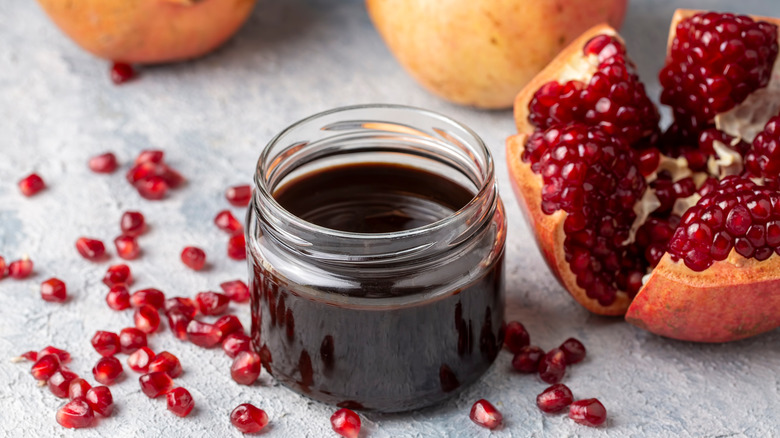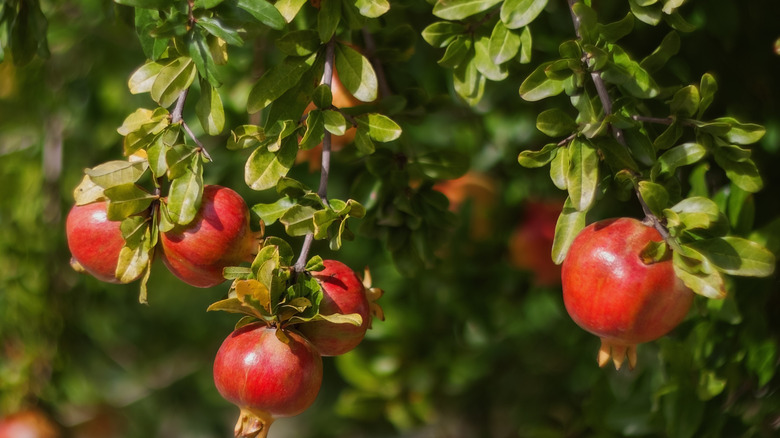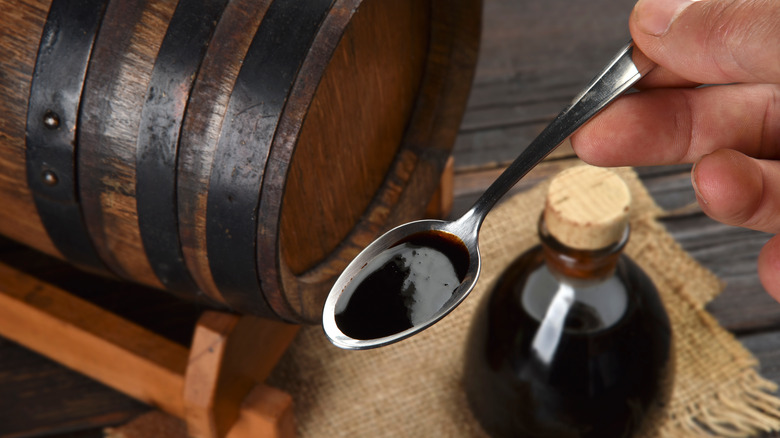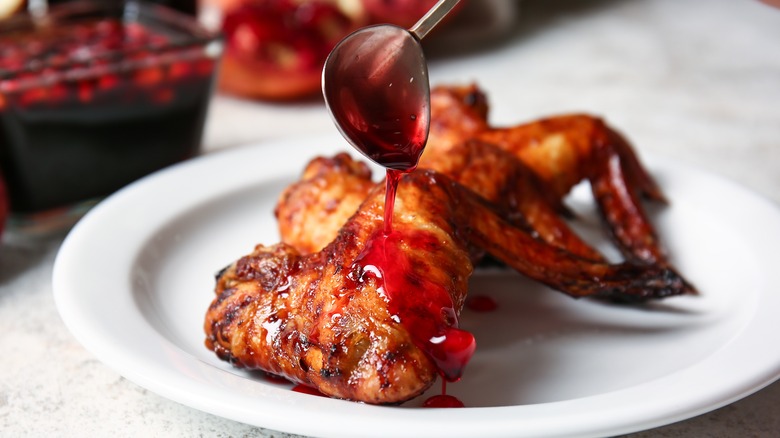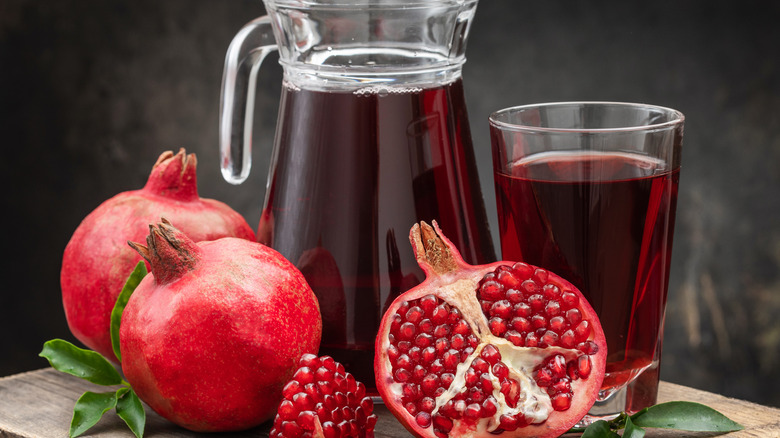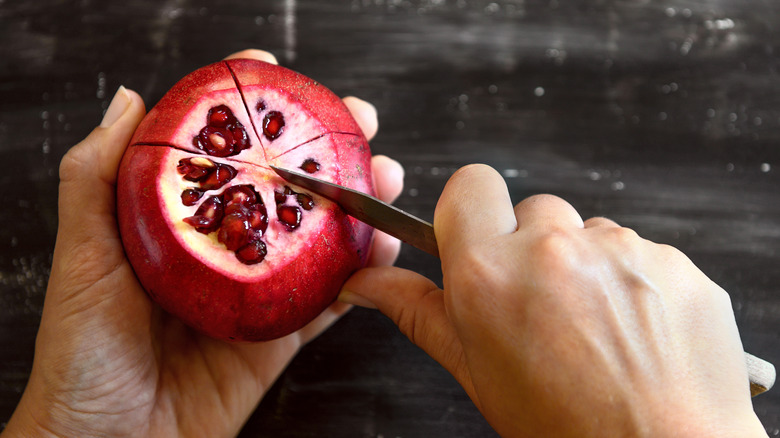What Is Pomegranate Molasses And What Dishes Is It Best In?
We may receive a commission on purchases made from links.
Pomegranate is one phenomenal fruit. One of America's greatest superfood obsessions, the ruby red orb seems to have endless beneficial properties for health and wellness. It's no surprise then that the pomegranate industry is valued over $8 billion dollars and expected to grow 14% by 2026 (via AgriExchange).
The amazing thing about pomegranates is their versatility. With seeds that can be eaten raw as a sweet treat, you can also cook with pomegranates, juice them and even make pomegranate molasses. Tart, fruity, ever-so-adaptable, pomegranate molasses is an ingredient that you're going to want to add to your pantry immediately.
Praised by celebrity chefs and home cooks alike, pomegranate molasses isn't actually like molasses at all. Where standard molasses is made by refining sugar beet and cane to create a sweetener, pomegranate molasses is a condiment. It's used to flavor just about anything, but what exactly is pomegranate molasses?
What is pomegranate molasses?
The pomegranate is a large, circular fruit with a crown on one end that blossoms from tall, deciduous shrubs in the spring, explains Pacific Horticulture. Inside, the fruit is filled with membrane-coated chambers that house juicy, garnet seeds called arils. Ranging from 3 to 5 inches in diameter, pomegranates can vary in color or flavor depending on their cultivars, although most that make it onto North American shelves are ruby red with a sweeter flavor.
Also known by its scientific name punica granatum, the University of Florida explains that the pomegranate is part of the punicaceae family, which belongs to the order of flowering plants that include guava, eucalyptus, and jaboticaba.
These gem-speckled fruits are thought to have originated in the Middle East, although cultivation spread wildly through Asia and into the Mediterranean, before the Spaniards brought the vibrant ruby fruit to the Americas, notes The New York Times. Naturally, pomegranate molasses is said to have roots in the Middle East where tart pomegranate was used as a condiment to balance fatty foods. It can range in color but is typically a deep garnet hue, with a consistency of thick syrup.
How is pomegranate molasses made?
Making pomegranate molasses is fairly straightforward — all you need are pomegranates! Start by extracting the juice from seeds. Better Homes & Gardens outlines that this can be done by pulsing seeds in the blender and then straining or using a sieve and spoon to squeeze out juice. For a faster alternative, you can also buy pomegranate juice, but just make sure it's pure fruit juice.
Once you have enough (think 8 cups!), you can start making pomegranate molasses. Following Tasting Table's recipe, pour all of the liquid into a wide saucepan and let it reach a rolling boil on your stovetop. You can also add a squeeze of lemon or lime and a teaspoon of salt to balance the sweetness of the juice and create layers of flavor. Lower the burner to medium, and let the juice simmer, making sure to stir the mixture occasionally to prevent caramelization.
The process relies on the philosophy of steady, which means the pomegranate juice should simmer for roughly an hour. Simmering, according to Serious Eats, is the best way to extract maximum flavor while maintaining the vibrant hue from the pomegranate. At this point, it should be reduced by about 75%. Once it has reached this point, remove it from the heat and let it cool completely. Add the molasses to a sterilized jar and store in your fridge for up to 4 months.
Pomegranate Molasses vs. Grenadine
Pomegranate molasses is pomegranate syrup. Grenadine is also technically a pomegranate syrup. However, the two couldn't be more different. From the ways they're crafted to their color, taste, and use, the two ingredients should not be thought of as twins, but rather distant cousins.
Pomegranate molasses is made from pure pomegranate juice, which means its tawny, borderline-brown color, and fruity, acidic flavor come directly from the fruit. In comparison, Kitchn explains that grenadine is a pomegranate-flavored syrup made from a concoction of corn syrup and bright, red food dye. However, grenadine gets its name from the French word for pomegranate because the syrup was originally made with a base of pomegranate juice when it was first created, explains MasterClass.
While pomegranate molasses is used as condiment, in typical Middle Eastern dishes, grenadine is instead used as a syrup to add flavor and color to cocktails like the Tequila Sunrise or Shirley Temple.
What does pomegranate molasses taste like?
Vibrant, intense, tangy — the list of descriptors can go on forever. While it's tricky to pinpoint the exact flavor profile of this sticky condiment, generally speaking, it's the ideal balance of sweet and tart. The natural sugars found in the fruit create a candy-coated effect on the palate, but just for an instant, as slight sour notes trail close behind.
Pomegranate molasses also has insane intensity thanks to its through-the-roof acidity. More mouth-puckering than a squeeze of lemon, the condiment can cut through just about any fatty dish that needs a bit of balancing. Interestingly, Serious Eats explains that pomegranates contain water-soluble pigments called anthocyanins that give color to the fruit but can also increase astringency. This is why drinking pomegranate juice tends to be a bit mouth-drying. The same can be said for its thicker rendition, pomegranate molasses.
If you're allergic to pomegranates but want to experience a similar flavor, Wonderful Cook suggests looking no further than balsamic glaze. Rich with complexity, the reduced vinegar is acidic, fruity, and just a tad smoky, like pomegranate molasses. For a similar sweet-tart flavor, tamarind paste is also reminiscent of the condiment.
How to cook with pomegranate molasses
Pomegranate molasses is synonymous with Middle Eastern cuisine. A main ingredient in so many dishes, Saveur explains that it shines exceptionally well in muhammara (spicy, roasted pepper and walnut dip), kisir (bulgur salad), and lamb kofte (minced meat kebab) — but that's not all.
Beyond traditional options, the potential for pomegranate molasses is limitless. One of the best ways to use the condiment is for marinades or to glaze meat. Not only will it add much-needed acidity, but it'll also give a glossy sheen to a barbecued chicken leg or beef meatball.
Pomegranate molasses also works quite well with vegetables. Like balsamic glaze, a drizzle of molasses on top of roasted or grilled vegetables is a flavor explosion. A spoonful in bean stews and dips like hummus also add complexity. This tart syrup can even be used to dress fresh vegetables in a salad; simply swap vinegar for molasses.
If you've got a sweet tooth, pomegranate molasses also works well when drizzled over vanilla ice cream, pancakes or rice pudding. Food Network even suggests using it with macerated strawberries for angel food cake. It can also be a secret ingredient for baked goods that call for traditional molasses — think gingerbread!
Additionally, stirring a splash of pomegranate syrup into soda, iced tea and cocktails, can give beverages a major makeover. Like a sour natural grenadine, pomegranate molasses lends itself to just about any food or drink that could use a bit of tartness.
Where to buy pomegranate molasses
Although it was once only possible to find the tangy treat in the Middle East or at ethnic markets, jars or bottles of pomegranate molasses are likely to be found on the shelf on the international aisle of your grocery store, notes The Herald Times. Look for thick viscosity, deep colors, and check the label as they might contain higher levels of sugar, changing the iconic flavor of authentic pomegranate molasses.
Since grocery stores will carry a variety of pomegranate products (fruit, seeds, juice) in the produce aisle, if you can't track down a bottle, you can always make your own. A few things to keep in mind when buying are to consider ice with no added sugar. If you buy arils, make sure to choose crimson morsels that aren't brown as they'll taste a bit off. If you're starting from scratch, Minnetonka Orchards advises choosing pomegranates that are large, hexagonal in shape, and heavy, to ensure maximum juiciness. Interestingly, the color of the rind has nothing to do with ripeness but rather variety.
Regardless of whether your pomegranate molasses is homemade or store bought, keep it in the refrigerator after opening. While it can keep for up to a year, it tends to thicken over time, affecting its texture and quality. This is why the New York Times recommends consuming it within three months.
Nutritional information about pomegranate molasses
Pomegranates have been deemed a superfood since ancient times when it was praised for its medicinal properties that supported digestive and reproductive health, helped wound healing, and even aided with nausea, according to Gastronomica.
While consuming the whole pomegranate (seeds and juice) will result in a greater source of nutrients and fiber, pomegranate juice still has some remarkable benefits. Along with being a source of folate and vitamin K, Healthline explains that pomegranate juice is rich with antioxidants like polyphenols and anthocyanins that help prevent the risk of cancer, support cardiovascular health, and reduce chronic inflammation. By default, pomegranate molasses has many of the same health benefits.
However, homemade is always healthier. A study done by Food Bioscience found that when compared to commercially produced samples of pomegranate molasses, homemade versions displayed higher antioxidant activity because of minimal processing and refining.
While pomegranate molasses is unlikely to cause harm, those with allergies to pomegranate should avoid this condiment. Likewise, people living with diabetes should also monitor the effects, as overconsumption could affect sugar levels.
Other varieties of pomegranate molasses
Not all pomegranate molasses are created equal. Levels of acidity and sugar can vary depending on which cultivar is used. For example, the Slow Food Foundation for Biodiversity outlines different local varieties like Iraqi aswad, Saudi Arabian mangulati, and Lebanese malissi. That said, for the tartest syrup, less sweet varieties are often used.
Along with differing composition, the price of pomegranate molasses can also range. Lower quality condiments may start at $5 working their way up to $25, depending on the type of pomegranate and methods used, as shown on Amazon.
You can also find organic versions of the pomegranate syrup, along with versions that are certified kosher shares The Spruce Eats — just steer clear of imposters, that is, grenadine or standard molasses.
With more varieties than possible to imagine, whether you buy or make pomegranate molasses, the results are guaranteed to please. The ideal condiment for just about anything, this antioxidant-rich syrup is a tart, tangy masterpiece that you need to try!
